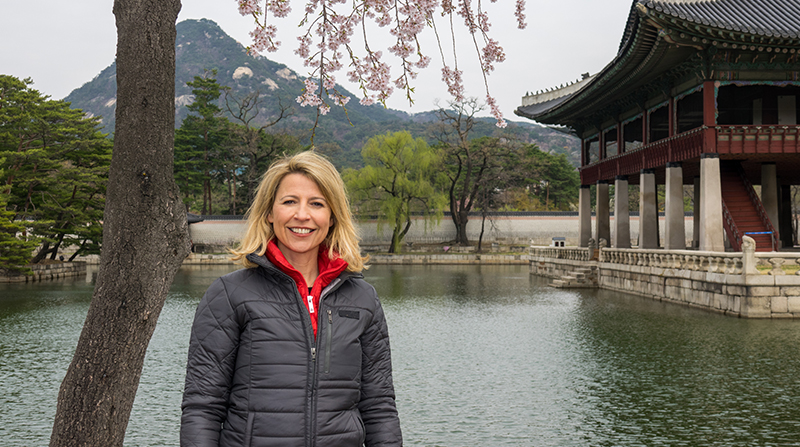

Samantha Brown in Seoul. Credit: Samantha Brown
In the Montreal episode of PBS’s fun, energetic Samantha Brown’s Places to Love, the series’ namesake rides a bike, crashes a block party and tours a market — all within the show’s first 10 minutes. But that’s the frantic pace the camera needs to move with if it intends to capture all the things that Brown wants to showcase.
Anyone who’s followed Brown’s travel exploits over the last 15 years should not be surprised by any of this; the Brooklyn-based mother of twins has made a career out of showing you a world of adventure from your couch. She recently talked to Forbes Travel Guide about Places to Love’s second season (premiering on January 5), the region of the world that got her hooked on travel and the secret to staying sane while you’re on the road with children.
When you prep for a trip, what is your routine? Do you pack three days in advance or 10 minutes before you need to be at the airport?
I’m definitely an advance kind of person. One of the things that really helps me — especially since not only do I pack for myself but sometimes I’m packing for two children as well — is like a week before a big trip, I just put out a pad of paper and start writing, kind of a stream of conscious, things that I’ll need like, “Oh, that’s right. Bring the wipes. Don’t forget to bring the child’s ibuprofen.”
That kind of starts the dialog with me and my suitcase. So, it always begins with a list and what I pack for myself. I know what I need, but when there’s more people, it gets a little more complicated. Then like two days before, I’ll start to pack up my bags and get them ready. So, yeah, I’m definitely a preplanner. My husband is a “Throw the clothes into the suitcase and just hope for the best” [kind of traveler].
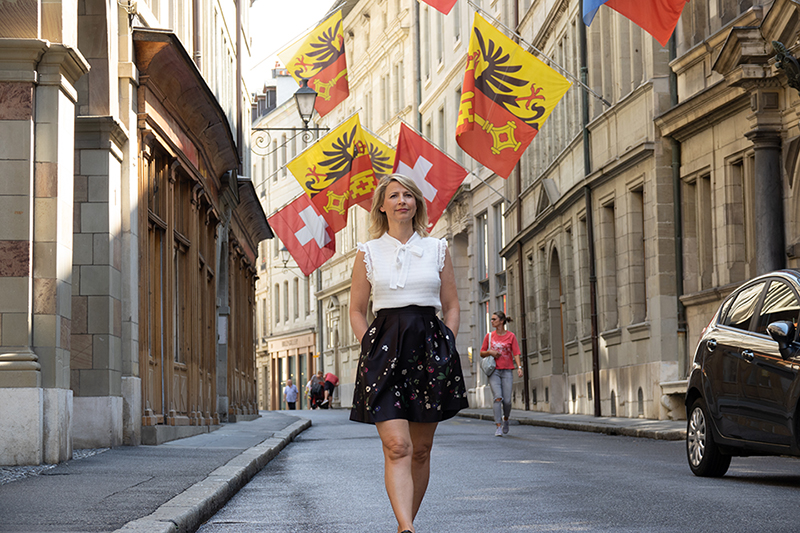
Sam in Switzerland. Credit: Samantha Brown
What are a few Samantha Brown essentials for a trip?
You know what’s an odd thing [in my luggage]? I always travel with a teacup, like a porcelain teacup because I travel so much, and I get really tired of unwrapping plastic off of paper cups in my hotel room. I just want to start my day real. I’ve become kind of an old lady now. I bring my slippers. I bring my teacup. Soon I’ll be knitting. It will be great.
I guess that I bring things that keep me comfortable. And I always have a neck scarf because it keeps me comfortable and it’s kind of feeling like home and cozy on the road.
Another thing I always travel with is peanut butter. If I’m going on a long trip overseas, I’ll bring a whole jar. And you can always find things to go with peanut butter. And if you’re really desperate, you can just dip your finger in it. A lot of times I’m arriving on overnight flights and maybe there’s no room service at the hotel. Maybe it’s too late.
I do travel with a lot of food. Again, it’s the old lady in me. But even when I’m not checking a bag — peanut butter does count against your liquids — I’ll bring those little Jiffy one-packs. I’ve always found that as a traveler, the worst mistakes I’ve made, whether I’ve made planning mistakes on the go or I’ve been rude, and I’ve blown up, is because I just got hungry. If I had just had like 300 more calories, none of it would have happened.
You’d be the perfect for a Snickers commercial.
I would totally be good for a Snickers commercial. So true. Everyone is like, “You’re so nice.” I’m like, “Oh, I’m like the Hulk. You wouldn’t like me when I’m angry.” And [the attitude] goes fast. And it’s always because I’m hungry. So, I make better decisions when [I eat].
https://www.instagram.com/p/BmV7EdRHIrY/
How do you keep your twins happy on the road?
That’s getting easier. We’ve traveled with them since they were three months old. There are a lot of techniques that I use that were brilliant, but now that they’re getting older, it just doesn’t work. So, it’s always dependent on the age of children.
But there were always two things that I traveled with: bubbles and balloons. Balloons can be inflated immediately, and you have a toy that they can whack around, run after and use some energy, and it’s not disturbing anyone else. I would bring it out if we had to wait in baggage claim for a long time for our bags. And it doesn’t matter how hard you whack a balloon, it goes two inches, so it doesn’t hurt a thing for anybody. Bubbles do the same thing.
And a big tip that I always tell people — and again, we don’t do this anymore because they’re older — is that parents approach the pre-board wrongly. Of course, as parents of young children, you get to board the flight pretty early. You see all the families kind of come [and board when called]. But what I usually do is have [one of the parents] use the pre-board to set up the car seats or secure the overhead bin space, which we know goes fast. And then I wait with my kids until the last zone is called and the last person gets on the flight. Then, we walk on the plane, we put them in their seats. Then, in 10 minutes, the plane is ready for takeoff.
So, by avoiding the pre-board, you’re doing a few things: one, you’re not subjecting a young child to what is absolutely the most stressful part of the plane ride; two, then you’re sitting on the plane for 45 minutes more than the actual flight time, and you know how children are affected by that.
And, God forbid, you’re delayed. Now you’re waiting on top of that time. But when you’re at the gate, you’re walking around, you’re blowing bubbles and you’re letting them hit balloons. So, they’re working out all of that energy. Then, you walk on and now they’re not going to be stressed.
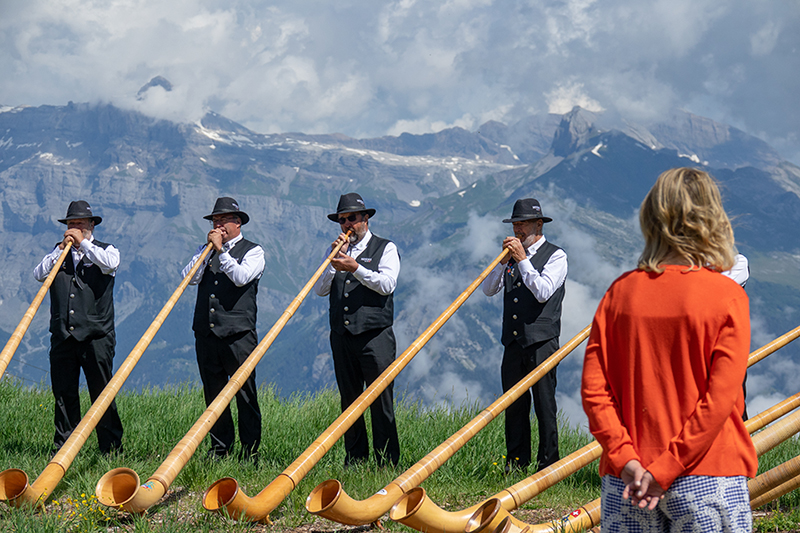
Getting to Know the Geneva Locals. Credit: Samantha Brown
When did you know you wanted to make a profession out of traveling?
It actually wasn’t until my job. I got the job and I thought, “What’s a host?” I had never really traveled before. But this was when I was doing a show called Great Vacation Homes, which was just about going to people’s vacation homes and spending time. It was more like a people piece.
Then, I started to do real travel and I had no idea what I was doing or what I was talking about. I did a whole show [Passport to Europe] in Europe and I thought, “Yeah, travel is okay. I like it.” Europe’s a lot about being in the past, visiting cathedrals and monuments.
But then I went to Latin America and I did a show there. I did an entire series [Passport to Latin America] there. That’s when I realized I loved travel and I wanted to be a part of it. And that’s because Latin America didn’t have all the pomp and circumstance of Europe. They didn’t have 10 museums. They didn’t have the block after block of gorgeous architecture. It just had people. And how they live now.
And I love being in the moment with the people and culture. I just needed to approach it much differently than I had seen on TV and just create a different path for myself. Europe didn’t really convince me that I wanted to be a traveler. Latin America did.
Places to Love seems to have a strong theme about the people in these destinations.
You hit the nail on the head. And it’s not just about the people, but I really concentrate on the effort that the people take and make to create the experience that we as travelers get to show up and have.
In the past, my shows were always about how I was experiencing things. What is the actual experience? But in Places to Love, I want to know the backstory behind that experience. Are you an immigrant from Mexico who came here in the back of a car and now you’re a James Beard Award winner? How hard did you work to create this [experience] for travelers?
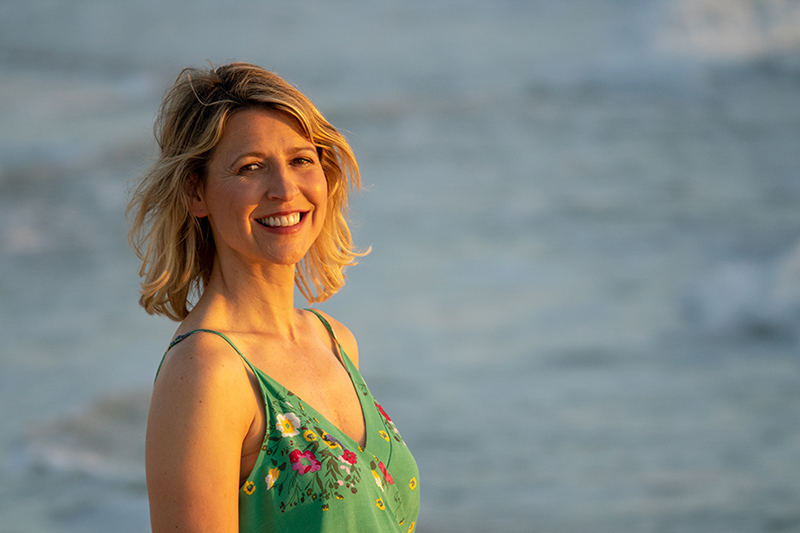
All Smiles in Florida. Credit: Samantha Brown
It’s definitely my belief that once we as travelers find out how hard someone had to work to create what they have, all we want to do is support that effort and make sure that it survives. And to me, that really taps into what everyone talks about when they say, “Be a local” or “Go where the locals go.” It’s not just about going where the locals go; it’s really about understanding what drives them. That, in turn, completely inspires us. For me, that is what travel has always been about — just people.
So, in my series, I make sure that the people I meet are people you can meet. I don’t have VIP access to people. I don’t talk to people you would never have access to. It’s really about showing the viewer, the traveler, what is possible next week, whether it’s a tour, a great piece of art or a great band. So yeah, it’s always about the people.
What are the people and places you’re excited to introduce us to during Places to Love’s new season?
I’ve been helping to edit the Lafayette, Louisiana, show. Every time I go to Louisiana, I go to New Orleans. I love New Orleans but come on! Lafayette is home to both Creole and Cajun cultures. So, not only do you have this amazing zydeco music and Cajun music, you have a group of people living there that literally live by the motto that no one is ever a stranger. If you’re there, you are part of the family.
I went to a zydeco festival and everyone’s dancing. It’s such a great relationship between the zydeco band and the dancers. All I can do is bop, so I didn’t know what to do. I go and take dance lessons, right? They teach me, so now I don’t just do the New Hampshire bop. I’m right there with the zydeco dancers.
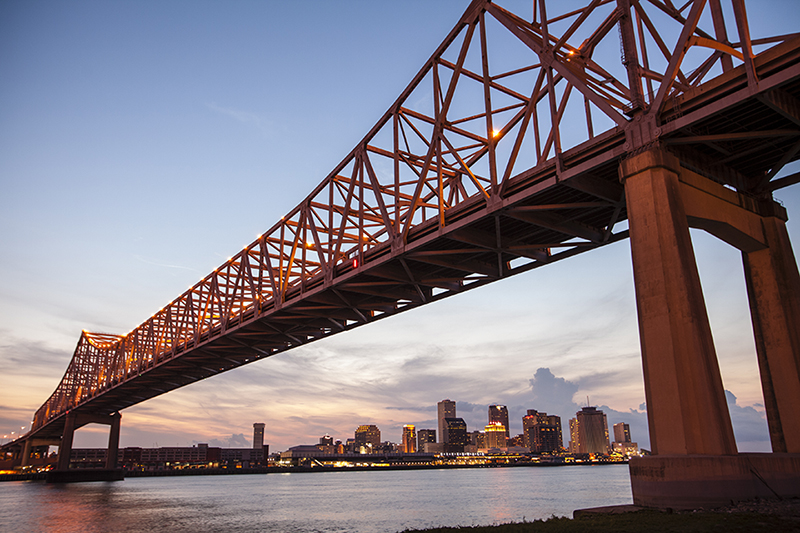
Lovely Louisiana. Credit: Richard Nowitz
I joined a crawfish farmer who actually runs a B&B. That can be part of your experience, too. There’s a lot of understanding of that culture. And it’s really amazing because they, especially the Cajun people, came from Europe by way of Canada. They settled in Louisiana and they’re French. And they still speak French fluently. And they still have their music.
And that’s never happened in America. We feel that everyone has to ditch their culture immediately to blend in, assimilate. But they never did. And I just find that fascinating. I love Cajun country. I really love the under-the-radar gems of travel.
What’s your advice to that person who wants to explore a little more but just needs that nudge to get outside of her comfort zone and leave her city?
I’ve always said that life-changing travel doesn’t have to be bucket-list big. You don’t have to go 10,000 miles to have a really wonderful experience. They could be day trips. They could be weekend trips.
One thing that we’re all guilty of is we never recognize our own state as an interesting place to go. Just start locally. And I think the idea of even going a few hours away from where you live [is a good one]. If you live in a city, go to the country. If you live in the country, go to the city. Stay in a hotel.
You’ll experience the change that happens when you travel, which is you’re not surrounded by what you know. It’s refreshing. It’s eye opening. It really does open your mind, not being always surrounded by the familiar.
